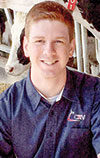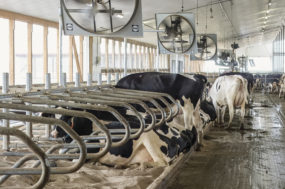The dairy world, both the production industry and the commodity market sides, is at a pivotal moment. No longer is fluid milk the leading driver of milk prices; now, the solids within milk have the power. Sure, a producer can make a little more money by shipping more hundredweights, but at the cost of the efficiency of the dairy. The good news for the dairy producer is that boosting the premium dollars on their milk check can be as simple as choosing the right bulls.
Market changes
This past year was huge for the U.S. dairy export markets, and as we all know, fluid milk had nothing to do with it. The real question is: Where are all these components going? According to the U.S. Dairy Export Council, within the first 10 months of 2013, Chinese imports were up 24 percent from 2012, leaving markets very tight.
Because of this, U.S. dairy exports totaled more than 15 percent of 2013 milk production, or production from 1.44 million cows. In total, exports from 2013 were valued at $5.54 billion. With such a large sum of money at stake, U.S. dairy producers need to take advantage.
Genetics with a purpose
Now you might be thinking, “I can just increase fat by increasing the forage amount in my ration,” but what happens when quality forages are in short supply due to drought or increased competition in the market? And what about protein?
To be competitive in global markets, dairy producers should be selecting genetics with a purpose: to increase milk component production. The good news here is that fat and protein production are among the top traits for heritability.
When we compare fat and protein to traits such as somatic cell score (SCS) or reproductive traits, fat and protein pounds average up to 30 percent, with fat and protein percentage at 50 percent versus SCS at 10 percent and reproduction as low as 7 percent.
This means that if a producer puts equal selection on fat and protein and reproduction, such as DPR, they will see a much more rapid improvement in their cows’ component production.
Not only can changes be made more quickly, but selection based on components can reduce the effects of selection for milk production, which has a large negative correlation with reproductive performance. Often, a management style adjustment can yield much more positive results for reproduction than genetically selecting for it.
Benefits of component cows
Selecting genetics with the purpose of creating “component cows” can have more benefits than just adding premiums to your milk check. Because the genetic makeup of the cow is calling for more components to be produced, cows will have an improved level of feed efficiency.
Increased levels of efficiency can not only help to improve a producer’s income over feed costs but can help the dairyman to position the herd to be sustainable for many years to come.
With less pressure to increase pounds of milk and more on raising component percentages, a producer will see an improvement in their herd’s health as well. Cows will experience improved hoof and udder health, as well as have more energy to be reproductively fit.
Global dairy is changing
The global dairy industry is changing, and U.S. dairy producers and cooperatives need to improve our competitive advantage.
Countries where the majority of their production is exported, such as several European countries and New Zealand, have been focusing on components for several years and have been able to position themselves as export leaders.
With U.S. milk exports now more than 15 percent of total production and increasing, the possibility of changes to the national milk pricing system that focus more on components is not a fantasy.
To take advantage of the increase in value of components, U.S. dairy producers should begin selecting genetics to produce more milk solids. Because fat and protein heritability is so high, several genetics companies have already begun selecting genetics with the purpose of increasing a producer’s component premiums, and dairy producers should take full advantage. PD
Matthew Costello
Project Assistant
CRV






